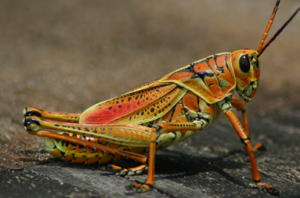

Floridians has some pretty spectacular insects. You have to go looking for most of them, but it’s hard to miss the Eastern Lubber grasshopper. The Eastern Lubber or Romalea Guttatta is probably the most well-known grasshopper in the Southeastern United States and is the largest variety. Even though their colors can vary, they usually have a combination of yellow, red and black. These designs are classified as aposematic, a group signaling warning colors, that it contains toxins and will make any potential predator sick. If for any reason, you fail to heed the color warning and pick it up, the grasshopper makes a loud hissing noise and secretes an irritating foul smelling foamy spray as a defense mechanism.
They can accumulate along weedy, wet drainage ditches or field margins and then feed on cultivated crops or ornamental plants, especially amaryllis and related flowers, according to a fact sheet from the University of Florida extension service.
Most lubber grasshoppers are poor jumpers, cannot fly, and move rather slowly. Contrary to the typical thought that this would place them at a disadvantage, they have evolved to the point of a being dominant species in the ecosystem. The lubber’s only natural predator is the loggerhead shrike, a small bird that decapitates them and then impales the body segment on sharp twigs or thorns so the sun can bake the toxins out before consumption.
Feeding on broadleaf plants, they can become a nuisance when swarms invade residential areas and feast on garden plants and vegetables. Lubbers seem to be unaffected by most insecticides, and according to experts at the University of Florida, if they become a garden pest, the best way to get rid of them is to stomp on them, or while wearing gloves, hand pick and drown them in a container of soapy water.
One particularly effective pesticide is Nolo Bait. This is an organic biological insecticide mixed with wheat bran, using a natural food source as an attractant. This is applied around gardens, fruit trees, ornamental plants, and surrounding areas. When the nymphs eat it, they die. When adults eat it, some may die but most are rendered sterile, so they can’t lay eggs.
